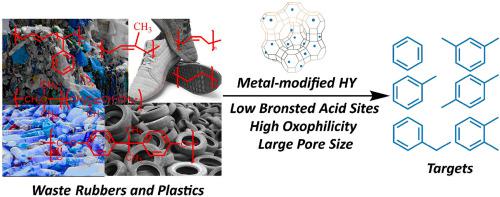Journal of Cleaner Production ( IF 9.7 ) Pub Date : 2021-05-10 , DOI: 10.1016/j.jclepro.2021.127469 Jia Wang , Jianchun Jiang , Yunjuan Sun , Xiaobo Wang , Mi Li , Shusheng Pang , Roger Ruan , Arthur J. Ragauskas , Yong Sik Ok , Daniel C.W. Tsang

|
Catalytic conversion of waste rubbers and plastics into aromatic hydrocarbons is a promising approach to waste management and energy recovery. In the present study, acidic HY zeolites were supported by cobalt, iron, and zirconium, and the catalysts were characterized by powder X-ray diffraction, nitrogen adsorption-desorption, ammonia temperature programmed desorption, X-ray photoelectron spectroscopy, and pyridine-Fourier transform infrared spectroscopy. The catalytic degradation of waste polybutadiene rubbers (BR) was conducted to investigate the degradation mechanism and evaluate the catalytic activity of supported zeolites. Experimental results indicated that HY loaded by zirconium and iron led to a higher content of Lewis acid sites as opposed to cobalt supported one. Compared with the non-catalytic pyrolysis of BR, the zirconium supported HY (Zr/HY) led to a 10-fold increase in aromatic hydrocarbons production with a distinctively high selectivity of 97.9%. A series of waste polymers including waste tires (WT), polyethylene (PE), polycarbonate (PC), and BR, were subjected to catalytic pyrolysis to explore the effects of polymer type on aromatic hydrocarbons generation, and BR was the most effective substrate, with yield enhancement reaching 2.4 over Zr/HY. Catalytic co-pyrolysis of waste rubbers and plastics was conducted to probe the effect of polymer structure on aromatic hydrocarbons formation, where a significant synergistic effect was observed in the PE co-fed with PC run.
中文翻译:

在沸石上催化降解废橡胶和塑料以生产芳烃
将废旧橡胶和塑料催化转化为芳烃是一种有前途的废物管理和能量回收方法。在本研究中,酸性HY沸石由钴,铁和锆担载,催化剂通过粉末X射线衍射,氮吸附-解吸,氨温度程序解吸,X射线光电子能谱和吡啶-傅里叶表征。变换红外光谱。进行了废旧聚丁二烯橡胶(BR)的催化降解研究,研究了降解机理并评估了负载型沸石的催化活性。实验结果表明,与钴负载的钴相反,锆和铁负载的HY导致较高的Lewis酸位含量。与BR的非催化热解相比,锆负载的HY(Zr / HY)使芳烃的产量增加了10倍,选择性高达97.9%。对包括废轮胎(WT),聚乙烯(PE),聚碳酸酯(PC)和BR在内的一系列废聚合物进行了催化热解,以探索聚合物类型对芳烃生成的影响,BR是最有效的底物,与Zr / HY相比,产量提高了2.4倍。进行废橡胶和塑料的催化共热解以探讨聚合物结构对芳烃形成的影响,其中在与PC运行共混的PE中观察到了显着的协同作用。对聚乙烯(PE),聚碳酸酯(PC)和BR进行了催化热解,以探讨聚合物类型对芳烃生成的影响,BR是最有效的底物,与Zr / HY相比,收率提高了2.4。进行废橡胶和塑料的催化共热解以探讨聚合物结构对芳烃形成的影响,其中在与PC运行共混的PE中观察到了显着的协同作用。对聚乙烯(PE),聚碳酸酯(PC)和BR进行了催化热解,以探讨聚合物类型对芳烃生成的影响,BR是最有效的底物,与Zr / HY相比,收率提高了2.4。进行废橡胶和塑料的催化共热解以探讨聚合物结构对芳烃形成的影响,其中在与PC运行共混的PE中观察到了显着的协同作用。











































 京公网安备 11010802027423号
京公网安备 11010802027423号